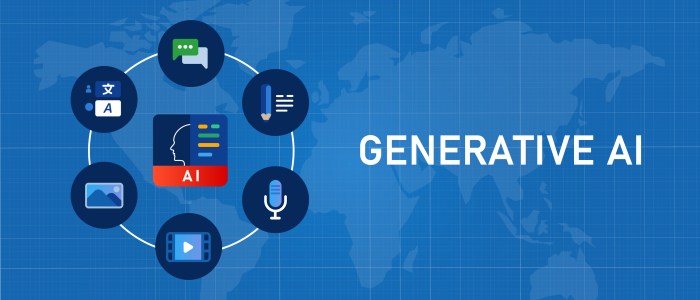What Does Fairness in Generative AI Entail?
What does the principle of fairness in genai entail – What does the principle of fairness in generative AI entail? In a world where machines are increasingly capable of creating content that mimics human creativity, ensuring fairness becomes a paramount concern. Generative AI, with its ability to produce text, images, code, and even music, raises questions about how to guarantee that these outputs are unbiased and reflect a diverse range of perspectives.
This exploration delves into the core principles of fairness in generative AI, the factors that influence its application, and the strategies needed to mitigate bias and promote ethical development.
The potential of generative AI is immense, promising to revolutionize fields like art, education, and scientific research. However, as with any powerful technology, there are inherent risks. Bias, discrimination, and the perpetuation of harmful stereotypes can easily creep into AI systems, particularly those trained on massive datasets that may contain implicit biases.
To harness the full potential of generative AI while minimizing its risks, we must establish clear guidelines and practices for achieving fairness.
Factors Influencing Fairness in Generative AI

Ensuring fairness in generative AI models is crucial to prevent biased or discriminatory outputs. Several factors contribute to the fairness of these models, and understanding them is essential for building ethical and responsible AI systems.
Data Bias
Data bias is a significant factor influencing the fairness of generative AI models. The data used to train these models often reflects societal biases, leading to biased outputs. For instance, if a language model is trained on a dataset that predominantly features male authors, it may generate text that perpetuates gender stereotypes.
- Representation Bias: If the training data lacks sufficient representation of diverse groups, the model may struggle to generate outputs that are fair and unbiased. For example, a facial recognition system trained on a dataset with primarily light-skinned individuals may perform poorly on individuals with darker skin tones.
- Historical Bias: Data can reflect historical biases and prejudices, which can be perpetuated by AI models. For example, a language model trained on a corpus of text from the 19th century might generate text that reflects the racist and sexist attitudes prevalent during that era.
- Sampling Bias: The way data is collected and sampled can introduce bias. For example, if a survey on job satisfaction is conducted primarily in urban areas, the results may not accurately reflect the experiences of people in rural areas.
Model Architecture
The architecture of a generative AI model can also influence its fairness. Some architectures are more susceptible to bias than others. For example, models that rely heavily on statistical correlations between features in the training data may amplify existing biases.
- Overfitting: When a model is overfit to the training data, it may learn to reproduce biases present in that data, even if those biases are not representative of the real world.
- Feature Selection: The selection of features used to train a model can also contribute to bias. If certain features are excluded, the model may not be able to accurately represent the diversity of the data.
Training Methods
The methods used to train generative AI models can also impact their fairness. For example, certain optimization algorithms may be more prone to amplifying biases present in the training data.
- Regularization Techniques: Regularization techniques can help mitigate overfitting and reduce the impact of bias in the training data. However, the choice of regularization technique can also influence the fairness of the model.
- Hyperparameter Tuning: The tuning of hyperparameters during training can impact the model’s performance and fairness. It is crucial to carefully consider the impact of hyperparameter choices on bias.
Real-World Examples of Fairness Issues
Several real-world examples illustrate the importance of addressing fairness in generative AI applications.
- Facial Recognition: Facial recognition systems have been shown to be less accurate for people of color, particularly women and individuals with darker skin tones. This bias can have serious consequences, leading to misidentification and wrongful arrests.
- Language Models: Language models have been shown to perpetuate gender stereotypes and racial biases in their outputs. For example, a language model trained on a dataset of news articles may generate text that reinforces the stereotype of women being primarily associated with domestic tasks.
- Image Generation: Image generation models have been used to create images that reinforce harmful stereotypes. For example, a model trained on a dataset of images from social media may generate images that perpetuate stereotypes about certain ethnic groups.
Ethical Considerations in Generative AI Fairness: What Does The Principle Of Fairness In Genai Entail
The quest for fairness in generative AI goes beyond technical solutions. It demands a deep dive into the ethical implications of these powerful technologies, recognizing their potential to shape societal norms and influence individual experiences. Understanding the ethical considerations surrounding fairness in generative AI is crucial for responsible development and deployment.
Potential Societal Impacts and the Role of Human Oversight, What does the principle of fairness in genai entail
Fairness in generative AI is not merely a technical issue; it has profound ethical implications. The potential societal impacts of biased or unfair AI models are significant, ranging from perpetuating existing inequalities to creating new forms of discrimination. For example, a biased job recruitment AI could systematically exclude qualified candidates from certain demographic groups, perpetuating existing inequalities in the workforce.
To mitigate these risks, human oversight plays a critical role in ensuring that generative AI models are developed and deployed responsibly. This involves careful evaluation of the models’ outputs, continuous monitoring for bias, and the implementation of mechanisms for human intervention when necessary.
Transparency and Accountability in Generative AI
Transparency and accountability are essential pillars of ethical AI development. Users need to understand how generative AI models work, the data they are trained on, and the potential biases they might exhibit. This transparency fosters trust and allows for informed decision-making.
Accountability, on the other hand, ensures that those responsible for developing and deploying generative AI models are held accountable for their actions. This includes establishing clear lines of responsibility for potential harms caused by biased models and creating mechanisms for redress.
Key Ethical Principles for Fairness in Generative AI
The following table Artikels key ethical principles for ensuring fairness in generative AI, along with corresponding actions or strategies:
| Ethical Principle | Actions or Strategies |
|---|---|
| Non-discrimination | – Develop and use datasets that are representative of the target population.
|
| Transparency | – Provide clear documentation about the model’s development, training data, and potential biases.
|
| Accountability | – Establish clear lines of responsibility for the development and deployment of the model.
|
Final Summary
In conclusion, ensuring fairness in generative AI is not just a technical challenge but a moral imperative. By understanding the complexities of bias, developing robust metrics for evaluation, and implementing strategies for mitigation, we can work towards a future where AI systems are truly equitable and reflect the diversity of the human experience.
As generative AI continues to evolve, it’s crucial to remain vigilant, constantly refining our understanding of fairness and adapting our practices to ensure that this powerful technology serves the best interests of humanity.






